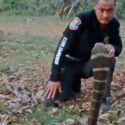Do you know what a serial killer looks like? You’d probably say they have long, greasy hair, dark clothing, and they spend a lot of time lurking in the shadows. So surely this handsome, young, charming man offering you a ride is nothing to worry about, right?
Wrong. This is Ted Bundy, one of the most vicious serial killers in history. And if you were to get in his car, you would probably never come back.
But too much time is spent focusing on his countless string of murders. Today we’ll be looking at the people who survived this cunning monster. What did they do to get out alive? And how can you use it to protect yourself from the other monsters out there?
During the 1970s, horrific crimes shocked the U.S. The victims were young women, most of them college students, who were beaten to death and sexually assaulted before and after they were murdered. It took years for the police to discover the killer, a charming, young, handsome man with a degree in psychology.
He was named Theodore Robert Bundy. After being caught and sentenced to death in 1979, the infamous killer claimed to have murdered anywhere from 36 to 50 women between 1974 and 1978. But some experts believe there could have been more than 100 victims.
Fortunately, there were also survivors. And we’ve put together their top three most incredible stories of how they got out alive. How did one survivor use water to escape? What are signs that you might be in danger? How can you fight back?
Number 3: The Sleep Talker
In 1974, 18-year-old Karen Sparks was a student at the University of Washington. She remembers seeing an older guy staring at her in a laundromat. And one night, she saw a man looking at her from outside her window. But she thought it was nothing. So she went to bed. But a few minutes later, a man was on her bed viciously beating her with a metal rod.
The sexual abuse she suffered split her bladder. The attacker also smashed her skull. Suddenly, her roommate, Chuck, began talking very loudly in his sleep. Bundy fled, leaving Karen for dead. Her roommates found her several hours later, bleeding and unconscious. They called 911 immediately.
Miraculously, she survived. But she was so severely injured that she suffered permanent brain damage and lost much of her vision and hearing.
Number 2: The counterattack
In November 1974, Carol DaRonch, then 18, was at a shopping mall in Murray, Utah, when a mysterious man approached her. He told her he was a police detective and that someone had tried to steal her car. He said she needed to go with him to the police station to file a report. The guy even showed her a badge, so she decided to give it a chance. In the parking lot, she saw her car was intact. But the man insisted on taking her to the police station in his car, a VW Beetle.
She got in. But at some point, Bundy stopped the car. He surprised her by grabbing one of her wrists and handcuffing her. But Carol started to struggle. Bundy was also trying to hit her with a crowbar, but she managed to open the passenger door. Luckily, a car was passing on the other side of the road.
Carol jumped in front of it with one of the handcuffs still dangling from her wrists. Bundy escaped. Carol survived, and a year later she identified Bundy in a police lineup, which led to his first prison sentence. Unfortunately, he escaped from prison in 1975 and continued his killing frenzy.
Before we move on to our number one survival story, let’s look at what we’ve learned so far. In our first two stories, we’ve seen the importance of being around other people. Serial killers don’t want witnesses around to complicate things. So if someone is giving you suspicious vibes, try to avoid getting into any situations where you’re isolated and alone with them.
Don’t trust strangers, and never underestimate signals like someone following you or insistently staring at you. As you’ll see in our number one story, recognizing these red flags could very well save your life.
Number 1: Saved by water
October 1974, Rhonda Stapley, a young pharmacy student at the University of Utah, was waiting for the bus to campus. A Volkswagen Beetle pulled up. The driver, a handsome and charming young man, offered her a ride. She accepted. When she got into the car, she noticed that the passenger door handle was broken, but she thought it was just an oversight.
She saw that the guy wasn’t driving the common route to campus, but he said he wanted to take a little detour to the zoo. Rhonda thought it might be the start of a college romance and agreed. But a few minutes later, Bundy stopped the car in the middle of the woods. He looked her straight in the face and said, “You know what? I’m going to kill you.” Then he began choking her until she fell unconscious.
For three hours, Bundy sexually abused Rhonda and beat her with inexplicable rage. Finally, the killer became distracted and returned to the car. Rhonda seized the moment and tried to run, but she fell into a raging stream of water. She survived, but she spent years dealing with PTSD.
According to the FBI, serial killers have traits like not feeling remorse or guilt, the need for control, and predatory behavior. It’s not easy to survive someone like that, especially if you can’t identify them.
Some serial killers’ identities have remained unknown for centuries, like the infamous Jack the Ripper. But in 2019, a study claimed to have found his identity. Want to know who he was?
Sources
- “Ted Bundy | Serial Killers | Crime Library – Crime Museum“. 2021. Crime Museum.
- “How Ted Bundy Got Away With So Many Murders, According To A Forensic Psychologist“. 2021. Insider.
- “Ted Bundy’S First Known Victim Believes A Random Coincidence Saved Her Life | Oxygen Official Site”. 2020. Oxygen Official Site.
- “The Women Who Survived Ted Bundy“. 2021. Crime+Investigation UK.
- “Ted Bundy“. 2021. Biography.



























